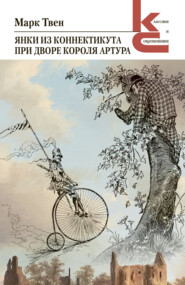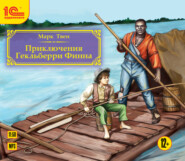По всем вопросам обращайтесь на: info@litportal.ru
(©) 2003-2025.
✖
A Tramp Abroad
Автор
Год написания книги
2015
Настройки чтения
Размер шрифта
Высота строк
Поля
In 1864 a party of tourists was descending Mont Blanc, and while picking their way over one of the mighty glaciers of that lofty region, roped together, as was proper, a young porter disengaged himself from the line and started across an ice-bridge which spanned a crevice. It broke under him with a crash, and he disappeared. The others could not see how deep he had gone, so it might be worthwhile to try and rescue him. A brave young guide named Michel Payot volunteered.
Two ropes were made fast to his leather belt and he bore the end of a third one in his hand to tie to the victim in case he found him. He was lowered into the crevice, he descended deeper and deeper between the clear blue walls of solid ice, he approached a bend in the crack and disappeared under it. Down, and still down, he went, into this profound grave; when he had reached a depth of eighty feet he passed under another bend in the crack, and thence descended eighty feet lower, as between perpendicular precipices. Arrived at this stage of one hundred and sixty feet below the surface of the glacier, he peered through the twilight dimness and perceived that the chasm took another turn and stretched away at a steep slant to unknown deeps, for its course was lost in darkness. What a place that was to be in – especially if that leather belt should break! The compression of the belt threatened to suffocate the intrepid fellow; he called to his friends to draw him up, but could not make them hear. They still lowered him, deeper and deeper. Then he jerked his third cord as vigorously as he could; his friends understood, and dragged him out of those icy jaws of death.
Then they attached a bottle to a cord and sent it down two hundred feet, but it found no bottom. It came up covered with congelations – evidence enough that even if the poor porter reached the bottom with unbroken bones, a swift death from cold was sure, anyway.
A glacier is a stupendous, ever-progressing, resistless plow. It pushes ahead of it masses of boulders which are packed together, and they stretch across the gorge, right in front of it, like a long grave or a long, sharp roof. This is called a moraine. It also shoves out a moraine along each side of its course.
Imposing as the modern glaciers are, they are not so huge as were some that once existed. For instance, Mr. Whymper says:
“At some very remote period the Valley of Aosta was occupied by a vast glacier, which flowed down its entire length from Mont Blanc to the plain of Piedmont, remained stationary, or nearly so, at its mouth for many centuries, and deposited there enormous masses of debris. The length of this glacier exceeded eighty miles, and it drained a basin twenty-five to thirty-five miles across, bounded by the highest mountains in the Alps.
“The great peaks rose several thousand feet above the glaciers, and then, as now, shattered by sun and frost, poured down their showers of rocks and stones, in witness of which there are the immense piles of angular fragments that constitute the moraines of Ivrea.
“The moraines around Ivrea are of extraordinary dimensions. That which was on the left bank of the glacier is about thirteen miles long, and in some places rises to a height of two thousand one hundred and thirty feet above the floor of the valley! The terminal moraines (those which are pushed in front of the glaciers) cover something like twenty square miles of country. At the mouth of the Valley of Aosta, the thickness of the glacier must have been at least two thousand feet, and its width, at that part, five miles and A quarter.”
It is not easy to get at a comprehension of a mass of ice like that. If one could cleave off the butt end of such a glacier – an oblong block two or three miles wide by five and a quarter long and two thousand feet thick – he could completely hide the city of New York under it, and Trinity steeple would only stick up into it relatively as far as a shingle-nail would stick up into the bottom of a Saratoga trunk.
“The boulders from Mont Blanc, upon the plain below Ivrea, assure us that the glacier which transported them existed for a prodigious length of time. Their present distance from the cliffs from which they were derived is about 420,000 feet, and if we assume that they traveled at the rate of 400 feet per annum, their journey must have occupied them no less than 1,055 years! In all probability they did not travel so fast.”
Glaciers are sometimes hurried out of their characteristic snail-pace. A marvelous spectacle is presented then. Mr. Whymper refers to a case which occurred in Iceland in 1721:
“It seems that in the neighborhood of the mountain Kotlugja, large bodies of water formed underneath, or within the glaciers (either on account of the interior heat of the earth, or from other causes), and at length acquired irresistible power, tore the glaciers from their mooring on the land, and swept them over every obstacle into the sea. Prodigious masses of ice were thus borne for a distance of about ten miles over land in the space of a few hours; and their bulk was so enormous that they covered the sea for seven miles from the shore, and remained aground in six hundred feet of water! The denudation of the land was upon a grand scale. All superficial accumulations were swept away, and the bedrock was exposed. It was described, in graphic language, how all irregularities and depressions were obliterated, and a smooth surface of several miles’ area laid bare, and that this area had the appearance of having been planed by A Plane.”
The account translated from the Icelandic says that the mountain-like ruins of this majestic glacier so covered the sea that as far as the eye could reach no open water was discoverable, even from the highest peaks. A monster wall or barrier of ice was built across a considerable stretch of land, too, by this strange irruption:
“One can form some idea of the altitude of this barrier of ice when it is mentioned that from Hofdabrekka farm, which lies high up on a fjeld, one could not see Hjorleifshofdi opposite, which is a fell six hundred and forty feet in height; but in order to do so had to clamber up a mountain slope east of Hofdabrekka twelve hundred feet high.”
These things will help the reader to understand why it is that a man who keeps company with glaciers comes to feel tolerably insignificant by and by. The Alps and the glaciers together are able to take every bit of conceit out of a man and reduce his self-importance to zero if he will only remain within the influence of their sublime presence long enough to give it a fair and reasonable chance to do its work.
The Alpine glaciers move – that is granted, now, by everybody. But there was a time when people scoffed at the idea; they said you might as well expect leagues of solid rock to crawl along the ground as expect leagues of ice to do it. But proof after proof was furnished, and the finally the world had to believe.
The wise men not only said the glacier moved, but they timed its movement. They ciphered out a glacier’s gait, and then said confidently that it would travel just so far in so many years. There is record of a striking and curious example of the accuracy which may be attained in these reckonings.
In 1820 the ascent of Mont Blanc was attempted by a Russian and two Englishmen, with seven guides. They had reached a prodigious altitude, and were approaching the summit, when an avalanche swept several of the party down a sharp slope of two hundred feet and hurled five of them (all guides) into one of the crevices of a glacier. The life of one of the five was saved by a long barometer which was strapped to his back – it bridged the crevice and suspended him until help came. The alpen-stock or baton of another saved its owner in a similar way. Three men were lost – Pierre Balmat, Pierre Carrier, and Auguste Tairraz. They had been hurled down into the fathomless great deeps of the crevice.
Dr. Forbes, the English geologist, had made frequent visits to the Mont Blanc region, and had given much attention to the disputed question of the movement of glaciers. During one of these visits he completed his estimates of the rate of movement of the glacier which had swallowed up the three guides, and uttered the prediction that the glacier would deliver up its dead at the foot of the mountain thirty-five years from the time of the accident, or possibly forty.
A dull, slow journey – a movement imperceptible to any eye – but it was proceeding, nevertheless, and without cessation. It was a journey which a rolling stone would make in a few seconds – the lofty point of departure was visible from the village below in the valley.
The prediction cut curiously close to the truth; forty-one years after the catastrophe, the remains were cast forth at the foot of the glacier.
I find an interesting account of the matter in the histoire du Mont Blanc, by Stephen d’Arve. I will condense this account, as follows:
On the 12th of August, 1861, at the hour of the close of mass, a guide arrived out of breath at the mairie of Chamonix, and bearing on his shoulders a very lugubrious burden. It was a sack filled with human remains which he had gathered from the orifice of a crevice in the Glacier des Bossons. He conjectured that these were remains of the victims of the catastrophe of 1820, and a minute inquest, immediately instituted by the local authorities, soon demonstrated the correctness of his supposition. The contents of the sack were spread upon a long table, and officially inventoried, as follows:
Portions of three human skulls. Several tufts of black and blonde hair. A human jaw, furnished with fine white teeth. A forearm and hand, all the fingers of the latter intact. The flesh was white and fresh, and both the arm and hand preserved a degree of flexibility in the articulations.
The ring-finger had suffered a slight abrasion, and the stain of the blood was still visible and unchanged after forty-one years. A left foot, the flesh white and fresh.
Along with these fragments were portions of waistcoats, hats, hobnailed shoes, and other clothing; a wing of a pigeon, with black feathers; a fragment of an alpen-stock; a tin lantern; and lastly, a boiled leg of mutton, the only flesh among all the remains that exhaled an unpleasant odor. The guide said that the mutton had no odor when he took it from the glacier; an hour’s exposure to the sun had already begun the work of decomposition upon it.
Persons were called for, to identify these poor pathetic relics, and a touching scene ensued. Two men were still living who had witnessed the grim catastrophe of nearly half a century before – Marie Couttet (saved by his baton) and Julien Davouassoux (saved by the barometer). These aged men entered and approached the table. Davouassoux, more than eighty years old, contemplated the mournful remains mutely and with a vacant eye, for his intelligence and his memory were torpid with age; but Couttet’s faculties were still perfect at seventy-two, and he exhibited strong emotion. He said:
“Pierre Balmat was fair; he wore a straw hat. This bit of skull, with the tuft of blond hair, was his; this is his hat. Pierre Carrier was very dark; this skull was his, and this felt hat. This is Balmat’s hand, I remember it so well!” and the old man bent down and kissed it reverently, then closed his fingers upon it in an affectionate grasp, crying out, “I could never have dared to believe that before quitting this world it would be granted me to press once more the hand of one of those brave comrades, the hand of my good friend Balmat.”
There is something weirdly pathetic about the picture of that white-haired veteran greeting with his loving handshake this friend who had been dead forty years. When these hands had met last, they were alike in the softness and freshness of youth; now, one was brown and wrinkled and horny with age, while the other was still as young and fair and blemishless as if those forty years had come and gone in a single moment, leaving no mark of their passage. Time had gone on, in the one case; it had stood still in the other. A man who has not seen a friend for a generation, keeps him in mind always as he saw him last, and is somehow surprised, and is also shocked, to see the aging change the years have wrought when he sees him again. Marie Couttet’s experience, in finding his friend’s hand unaltered from the image of it which he had carried in his memory for forty years, is an experience which stands alone in the history of man, perhaps.
Couttet identified other relics:
“This hat belonged to Auguste Tairraz. He carried the cage of pigeons which we proposed to set free upon the summit. Here is the wing of one of those pigeons. And here is the fragment of my broken baton; it was by grace of that baton that my life was saved. Who could have told me that I should one day have the satisfaction to look again upon this bit of wood that supported me above the grave that swallowed up my unfortunate companions!”
No portions of the body of Tairraz, other than a piece of the skull, had been found. A diligent search was made, but without result. However, another search was instituted a year later, and this had better success. Many fragments of clothing which had belonged to the lost guides were discovered; also, part of a lantern, and a green veil with blood-stains on it. But the interesting feature was this:
One of the searchers came suddenly upon a sleeved arm projecting from a crevice in the ice-wall, with the hand outstretched as if offering greeting! “The nails of this white hand were still rosy, and the pose of the extended fingers seemed to express an eloquent welcome to the long-lost light of day.”
The hand and arm were alone; there was no trunk. After being removed from the ice the flesh-tints quickly faded out and the rosy nails took on the alabaster hue of death. This was the third right hand found; therefore, all three of the lost men were accounted for, beyond cavil or question.
Dr. Hamel was the Russian gentleman of the party which made the ascent at the time of the famous disaster. He left Chamonix as soon as he conveniently could after the descent; and as he had shown a chilly indifference about the calamity, and offered neither sympathy nor assistance to the widows and orphans, he carried with him the cordial exécrations of the whole community. Four months before the first remains were found, a Chamonix guide named Balmat – a relative of one of the lost men – was in London, and one day encountered a hale old gentleman in the British Museum, who said:
“I overheard your name. Are you from Chamonix, Monsieur Balmat?”
“Yes, sir.”
“Haven’t they found the bodies of my three guides, yet? I am Dr. Hamel.”
“Alas, no, monsieur.”
“Well, you’ll find them, sooner or later.”
“Yes, it is the opinion of Dr. Forbes and Mr. Tyndall, that the glacier will sooner or later restore to us the remains of the unfortunate victims.”
“Without a doubt, without a doubt. And it will be a great thing for Chamonix, in the matter of attracting tourists. You can get up a museum with those remains that will draw!”
This savage idea has not improved the odor of Dr. Hamel’s name in Chamonix by any means. But after all, the man was sound on human nature. His idea was conveyed to the public officials of Chamonix, and they gravely discussed it around the official council-table. They were only prevented from carrying it into execution by the determined opposition of the friends and descendants of the lost guides, who insisted on giving the remains Christian burial, and succeeded in their purpose.
A close watch had to be kept upon all the poor remnants and fragments, to prevent embezzlement. A few accessory odds and ends were sold. Rags and scraps of the coarse clothing were parted with at the rate equal to about twenty dollars a yard; a piece of a lantern and one or two other trifles brought nearly their weight in gold; and an Englishman offered a pound sterling for a single breeches-button.
Chapter XLI
One of the most memorable of all the Alpine catastrophes was that of July, 1865, on the Matterhorn – already slightly referred to, a few pages back. The details of it are scarcely known in America. To the vast majority of readers they are not known at all. Mr. Whymper’s account is the only authentic one. I will import the chief portion of it into this book, partly because of its intrinsic interest, and partly because it gives such a vivid idea of what the perilous pastime of Alp-climbing is. This was Mr. Whymper’s ninth attempt during a series of years, to vanquish that steep and stubborn pillar or rock; it succeeded, the other eight were failures. No man had ever accomplished the ascent before, though the attempts had been numerous.
Mr. Whymper’s narrative We started from Zermatt on the 13th of July, at half past five, on a brilliant and perfectly cloudless morning. We were eight in number – Croz (guide), old Peter Taugwalder (guide) and his two sons; Lord F. Douglas, Mr. Hadow, Rev. Mr. Hudson, and I. To insure steady motion, one tourist and one native walked together. The youngest Taugwalder fell to my share. The wine-bags also fell to my lot to carry, and throughout the day, after each drink, I replenished them secretly with water, so that at the next halt they were found fuller than before! This was considered a good omen, and little short of miraculous.
On the first day we did not intend to ascend to any great height, and we mounted, accordingly, very leisurely. Before twelve o’clock we had found a good position for the tent, at a height of eleven thousand feet. We passed the remaining hours of daylight – some basking in the sunshine, some sketching, some collecting; Hudson made tea, I coffee, and at length we retired, each one to his blanket bag.
We assembled together before dawn on the 14th and started directly it was light enough to move. One of the young Taugwalders returned to Zermatt. In a few minutes we turned the rib which had intercepted the view of the eastern face from our tent platform. The whole of this great slope was now revealed, rising for three thousand feet like a huge natural staircase. Some parts were more, and others were less easy, but we were not once brought to a halt by any serious impediment, for when an obstruction was met in front it could always be turned to the right or to the left. For the greater part of the way there was no occasion, indeed, for the rope, and sometimes Hudson led, sometimes myself. At six-twenty we had attained a height of twelve thousand eight hundred feet, and halted for half an hour; we then continued the ascent without a break until nine-fifty-five, when we stopped for fifty minutes, at a height of fourteen thousand feet.
We had now arrived at the foot of that part which, seen from the Riffelberg, seems perpendicular or overhanging. We could no longer continue on the eastern side. For a little distance we ascended by snow upon the arête—that is, the ridge – then turned over to the right, or northern side. The work became difficult, and required caution. In some places there was little to hold; the general slope of the mountain was less than forty degrees, and snow had accumulated in, and had filled up, the interstices of the rock-face, leaving only occasional fragments projecting here and there. These were at times covered with a thin film of ice. It was a place which any fair mountaineer might pass in safety. We bore away nearly horizontally for about four hundred feet, then ascended directly toward the summit for about sixty feet, then doubled back to the ridge which descends toward Zermatt. A long stride round a rather awkward corner brought us to snow once more. That last doubt vanished! The Matterhorn was ours! Nothing but two hundred feet of easy snow remained to be surmounted.

















